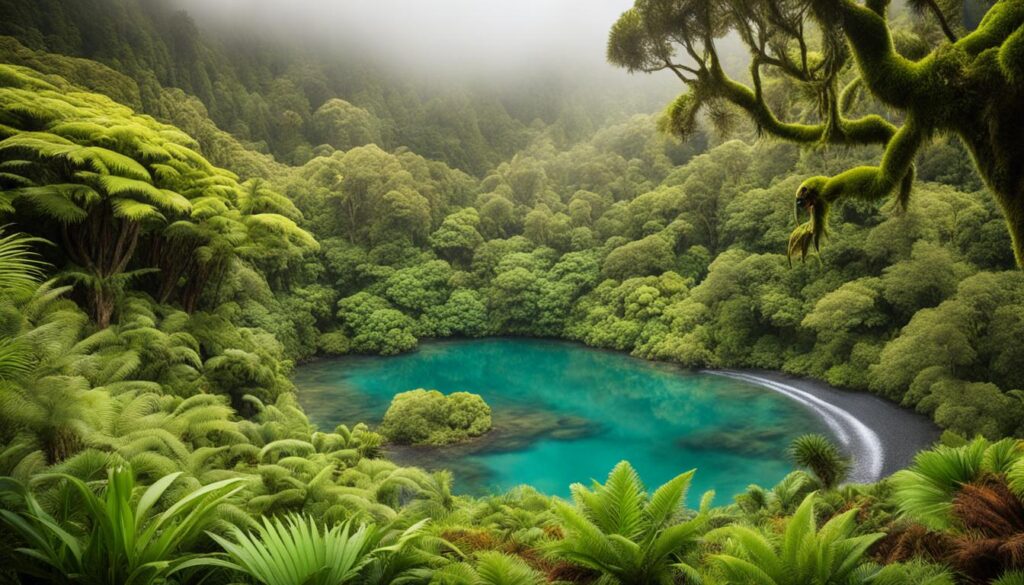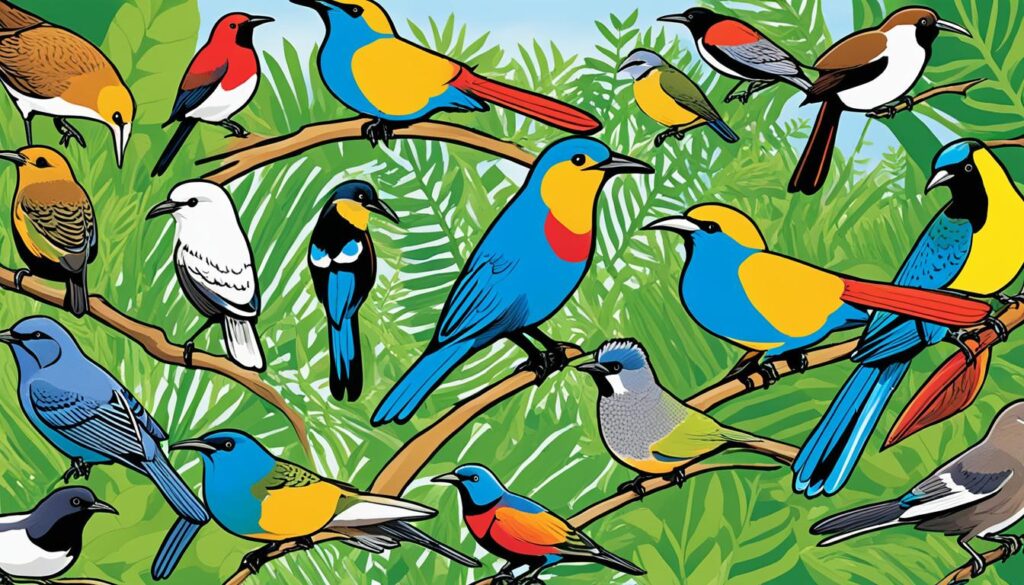New Zealand, a land of scenic beauty and rich biodiversity, is home to a surprising array of native wildlife. Did you know that this small island nation boasts over 51 species of native freshwater fish? From the iconic kiwi bird to marine mammals like dolphins and whales, New Zealand’s fauna is as diverse as it is fascinating.
Not only is New Zealand known for its unique wildlife, but it is also at the forefront of conservation efforts. With dedicated wildlife sanctuaries and a commitment to protecting endangered species, the country is striving to preserve its natural heritage for future generations.

Key Takeaways:
- New Zealand is renowned for its diverse and unique fauna.
- The country is home to a variety of native birds, marine life, reptiles, and invertebrates.
- Conservation efforts in New Zealand focus on protecting endangered species and preserving the natural environment.
- Wildlife sanctuaries play a vital role in providing a safe habitat for native wildlife.
- Visitors can explore the country’s stunning biodiversity while supporting conservation initiatives.
Birds of New Zealand
New Zealand is home to a diverse array of bird species, both in its lush forests and along its breathtaking coastlines. From magnificent seabirds to the iconic kiwi bird, the country’s avifauna is a testament to its rich natural heritage. Let’s explore some of the fascinating bird species that call New Zealand home.
Forest Birds
In the dense forests of New Zealand, a wide variety of unique bird species can be found. These forest birds have adapted to the country’s lush vegetation and cover a range of shapes, sizes, and colors. One notable example is the tūī, a beautiful songbird known for its melodic calls and iridescent feathers. Pīwakawaka, or fantails, are another common sight in New Zealand forests. With their distinctive fan-shaped tail and acrobatic flight, they add charm to the woodland setting. Other forest bird species include the kākā, kererū, and bellbird.
Seabirds
New Zealand’s coastal waters are teeming with an impressive array of seabirds, making it a true paradise for birdwatchers. The country is home to the albatross, one of the world’s largest seabirds with an impressive wingspan, capable of gliding for long distances over the ocean. Petrels, shearwaters, and gannets are also common sightings along the New Zealand coast. Among them, the appropriately named Australasian gannet stands out with its striking blue eyes and elegant flight.

Kiwi Bird
No discussion of New Zealand’s birdlife would be complete without mentioning the beloved kiwi bird. This flightless bird is not only a national symbol but also a unique and enchanting creature. With its small, stout body, long beak, and small wings, the kiwi is perfectly adapted to its forest habitat. These nocturnal birds are renowned for their shy nature and exceptional camouflage skills, making them a challenge to spot in the wild. Kiwis lay the largest eggs of any bird in the world relative to their body size, adding to their mystique.
Wildlife Sanctuaries
Given the importance of preserving New Zealand’s incredible birdlife, numerous wildlife sanctuaries have been established across the country. These sanctuaries provide protected habitats for endangered bird species, ensuring their survival for future generations to appreciate and admire. Examples of such sanctuaries include Tiritiri Matangi Island, Zealandia, and Kapiti Island, where conservation efforts are actively carried out to protect native bird species and restore their populations.
| Bird Species | Unique Characteristics |
|---|---|
| Tūī | Distinctive call and colorful plumage |
| Pīwakawaka (fantail) | Fan-shaped tail and acrobatic flight |
| Kākā | Intelligent and playful with vibrant plumage |
| Kererū (New Zealand pigeon) | Large, plump bird with iridescent feathers |
| Bellbird | Distinctive, melodic song |
| Albatross | Impressive wingspan and graceful flight |
| Petrels | Adept at long-distance oceanic flights |
| Gannets | Striking blue eyes and elegant flight |
The diverse birdlife of New Zealand truly adds to the enchantment of exploring the country’s natural wonders. Whether you’re venturing into the forests or admiring seabirds along the coast, the unique species that inhabit this island nation are sure to leave a lasting impression.
Marine Life in New Zealand
New Zealand’s marine environment is teeming with life, showcasing a diverse array of marine mammals, including dolphins, seals, and whales. One of the notable inhabitants of New Zealand’s coastal waters is the Hector’s dolphin, the smallest species of dolphin in the world. Known for their playful nature and communal behavior, these dolphins captivate the hearts of visitors and locals alike.
Whale watching is a popular activity in New Zealand, offering the opportunity to witness majestic creatures in their natural habitat. The country is frequented by species such as the impressive blue whale, the acrobatic humpback whale, the elegant southern right whale, and the iconic sperm whale. These encounters provide an unforgettable experience and contribute to the rich marine biodiversity of the region.
In addition to dolphins and whales, seals are commonly found along New Zealand’s coastline. They carve their way into the hearts of onlookers with their endearing nature and playful antics. Visitors can often witness these charismatic marine mammals in their natural habitat, basking on the rocks or swimming gracefully in the surrounding waters.
New Zealand’s waters also harbor various species of sharks, adding to the allure of the marine ecosystem. From the sleek and majestic great white shark to the fascinating hammerhead shark, these apex predators contribute to the balance and biodiversity of the region, showcasing the resilience and interconnectedness of marine life.
Marine Life Diversity in New Zealand
The rich marine biodiversity in New Zealand is a testament to the country’s commitment to conservation and preservation efforts. Its pristine waters and protected marine reserves have allowed an abundance of species to thrive, contributing to the delicate balance of the ecosystem.
Here is a comprehensive list of marine animals found in the waters of New Zealand:
| Marine Mammals | Predatory Fish | Marine Reptiles |
|---|---|---|
| Dolphins | Sharks | Turtles |
| Whales | Swordfish | Sea Snakes |
| Seals | Marlin | Kraits |
| Tuna |
These species contribute to the vibrant marine ecosystem and highlight the importance of protecting and preserving New Zealand’s marine environments for future generations.

The image above captures the beauty of the marine life found in New Zealand, showcasing the splendor and diversity of its underwater world.
Reptiles and Invertebrates in New Zealand
In addition to its diverse bird and marine life, New Zealand is also home to a fascinating array of reptiles and invertebrates. These unique creatures contribute to the country’s rich biodiversity and play important roles in the ecosystem.
A prime example of New Zealand’s reptile diversity is the tuatara. Known as a “living fossil,” the tuatara closely resembles lizards but has its distinct lineage. It is a remarkable reptile found only in New Zealand and is considered a national treasure.
New Zealand is also home to several species of geckos, skinks, and native frogs, many of which are rare and endangered. These reptiles are endemic to the country and can be found in various habitats, from forests to coastal areas.
Turning our attention to the invertebrates, New Zealand boasts a remarkable assortment of species. Crayfish, snails, and octopus populate the diverse aquatic ecosystems, while weta, a unique group of flightless insects, can be found in forests and grasslands.
New Zealand’s underwater world is adorned with colorful coral reefs that provide a habitat for a multitude of marine invertebrates. These intricate ecosystems contribute to the overall health and stability of the marine environment.
To showcase the diversity of reptiles and invertebrates in New Zealand, here is a table highlighting some notable species:
| Reptiles | Invertebrates |
|---|---|
| Tuatara | Crayfish |
| Geckos | Snails |
| Skinks | Octopus |
| Native Frogs | Weta |
| Coral |
The diversity of reptiles and invertebrates in New Zealand is a testament to the country’s unique ecosystem and the commitment to conserving its native wildlife.
Conservation Efforts in New Zealand
New Zealand is renowned for its strong commitment to conservation and the protection of its native wildlife. The country has implemented various initiatives and established numerous wildlife sanctuaries to provide a safe haven for endangered species and promote their preservation. These sanctuaries serve as crucial habitats where native flora and fauna can flourish, shielded from the threats posed by introduced species.
Conservation efforts in New Zealand are centered around preserving the natural environment, safeguarding endangered species, and advocating for sustainable practices. The country’s dedication to environmental preservation has yielded significant results, with the successful recovery of multiple species and the remarkable preservation of its unique biodiversity.
Through the collaborative efforts of the government, communities, and organizations, New Zealand continues to spearhead conservation initiatives that contribute to the long-term protection of its native wildlife. By investing in conservation programs and raising awareness about the importance of environmental stewardship, the country remains at the forefront of wildlife preservation, ensuring a sustainable future for its precious flora and fauna.
Conclusion
New Zealand’s unique fauna and diverse ecosystem make it an unparalleled destination for wildlife enthusiasts. From its native birds, marine life, reptiles, to the invertebrates, the country offers a remarkable array of species found nowhere else on Earth. Its commitment to conservation efforts and the establishment of wildlife sanctuaries have been instrumental in protecting and preserving this invaluable biodiversity.
Through ongoing efforts to safeguard endangered species and preserve the natural environment, New Zealand has emerged as a global leader in wildlife conservation. Its dedication to creating safe habitats through wildlife sanctuaries ensures the survival of these remarkable creatures for future generations to appreciate and cherish.
Visitors to New Zealand have the opportunity to witness the beauty and wonder of its unique fauna while actively contributing to conservation efforts. By supporting the preservation of this fragile ecosystem, they are actively participating in the protection of the country’s animals and the promotion of ecological sustainability. New Zealand’s dedication to wildlife conservation is an inspiration for the world, and its commitment to preserving the natural heritage should be acknowledged and celebrated.
